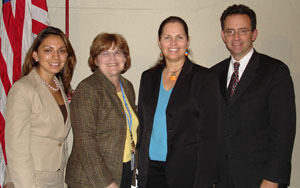| |
 |
|
|
|
|
| |
Dr. Cynthia Lindquist (second from r) is joined by (from l) Nicole Schuett, seminar coordinator; Dr. Janet Austin, director of the NIAMS Office of Communica-tions and Public Liaison; and John Burklow, NIH associate director for communications and public liaison. |
|
The need for cultural competency when developing
a health promotion or outreach effort with American Indians and Alaska Natives was recently addressed in a presentation by Dr. Cynthia
Lindquist, a member of the NIH director’s council of public representatives and president of Cankdeska Cikana Community College in North Dakota. Also known as Ta’sunka Wicahpi
Win (Star Horse Woman), Lindquist recently kicked off a seminar series for the NIH American Indian and Alaska Native health communications
workgroup at Lipsett Amphitheater.
Lindquist emphasized the need for understanding
the sociocultural aspects that may influence
the development and dissemination of effective health communication. “You need to understand our history. It’s different from other minority groups,” she said. Sharing her experiences
as a Dakota woman, she warned the audience of the dangers of making generalizations
when there are about 560 different federally
recognized Indian tribes. Each has unique needs, language and culture. But their commonalities,
she said, include their history, perspectives
and beliefs.
The history of the Native people of America is marked by racism, discrimination and oppression,
she said. And distrust of the federal government
remains. American Indians have a holistic, long-term perspective of the world, said Lindquist, emphasizing the connection between an individual with his or her family, community
and Mother Earth. Traditions and culture are the root of their belief system. “Something holy moving,” she said, is the Dakota expression
reflecting our relationship with one another and Earth. The underlying premise when working
with American Indians and Alaska Natives is to recognize the need to create connections, she emphasized. These cultures believe that we are all linked by a higher being.
Examples of cultural keys to consider when working
with American Indian and Alaska Native populations include: human interactions and relationship-building are important; identify a person in the community to act as a liaison; traditions
are embedded in the culture; elders and tribal elected officials are revered in their communities;
shake hands, but don’t stare for too long in the eyes; listen carefully and attentively; food and humor are good, always in a respectful way; be open-minded and have an open heart; be flexible with your time—things happens with a purpose when they need to happen; Indian country
moves cautiously, thoughtfully and slowly. 